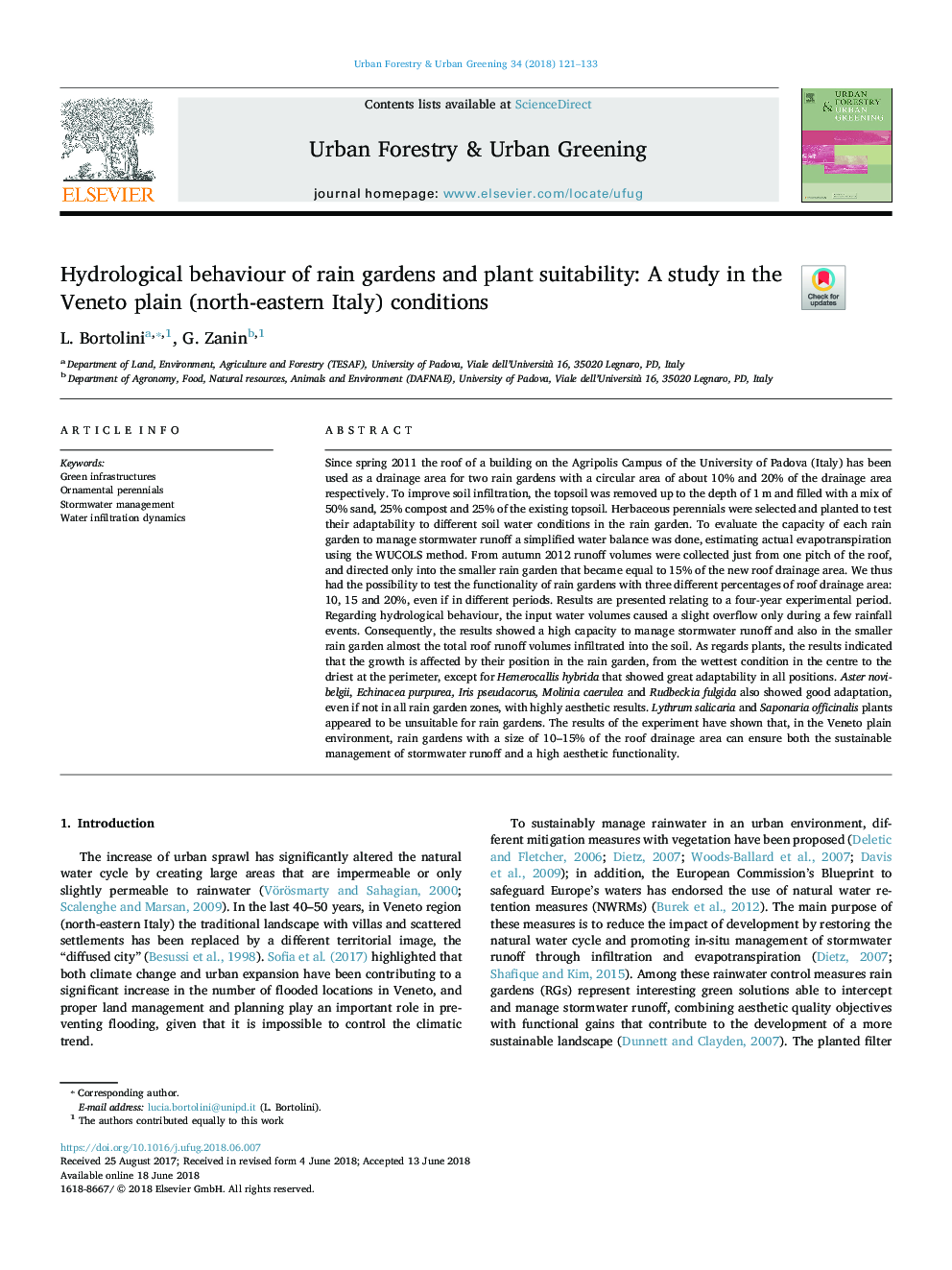| کد مقاله | کد نشریه | سال انتشار | مقاله انگلیسی | نسخه تمام متن |
|---|---|---|---|---|
| 6549083 | 1421856 | 2018 | 13 صفحه PDF | دانلود رایگان |
عنوان انگلیسی مقاله ISI
Hydrological behaviour of rain gardens and plant suitability: A study in the Veneto plain (north-eastern Italy) conditions
ترجمه فارسی عنوان
رفتار هیدرولوژیکی باغ های باران و مناسب بودن گیاه: مطالعه در دشت ونوتا (شمال شرقی ایتالیا)
دانلود مقاله + سفارش ترجمه
دانلود مقاله ISI انگلیسی
رایگان برای ایرانیان
کلمات کلیدی
زیرساخت های سبز، گیاهان زینتی، مدیریت طوفان، پویایی نفوذ آب،
موضوعات مرتبط
علوم زیستی و بیوفناوری
علوم کشاورزی و بیولوژیک
جنگلداری
چکیده انگلیسی
Since spring 2011 the roof of a building on the Agripolis Campus of the University of Padova (Italy) has been used as a drainage area for two rain gardens with a circular area of about 10% and 20% of the drainage area respectively. To improve soil infiltration, the topsoil was removed up to the depth of 1â¯m and filled with a mix of 50% sand, 25% compost and 25% of the existing topsoil. Herbaceous perennials were selected and planted to test their adaptability to different soil water conditions in the rain garden. To evaluate the capacity of each rain garden to manage stormwater runoff a simplified water balance was done, estimating actual evapotranspiration using the WUCOLS method. From autumn 2012 runoff volumes were collected just from one pitch of the roof, and directed only into the smaller rain garden that became equal to 15% of the new roof drainage area. We thus had the possibility to test the functionality of rain gardens with three different percentages of roof drainage area: 10, 15 and 20%, even if in different periods. Results are presented relating to a four-year experimental period. Regarding hydrological behaviour, the input water volumes caused a slight overflow only during a few rainfall events. Consequently, the results showed a high capacity to manage stormwater runoff and also in the smaller rain garden almost the total roof runoff volumes infiltrated into the soil. As regards plants, the results indicated that the growth is affected by their position in the rain garden, from the wettest condition in the centre to the driest at the perimeter, except for Hemerocallis hybrida that showed great adaptability in all positions. Aster novi-belgii, Echinacea purpurea, Iris pseudacorus, Molinia caerulea and Rudbeckia fulgida also showed good adaptation, even if not in all rain garden zones, with highly aesthetic results. Lythrum salicaria and Saponaria officinalis plants appeared to be unsuitable for rain gardens. The results of the experiment have shown that, in the Veneto plain environment, rain gardens with a size of 10-15% of the roof drainage area can ensure both the sustainable management of stormwater runoff and a high aesthetic functionality.
ناشر
Database: Elsevier - ScienceDirect (ساینس دایرکت)
Journal: Urban Forestry & Urban Greening - Volume 34, August 2018, Pages 121-133
Journal: Urban Forestry & Urban Greening - Volume 34, August 2018, Pages 121-133
نویسندگان
L. Bortolini, G. Zanin,
